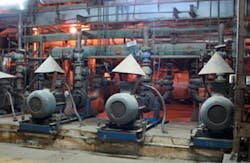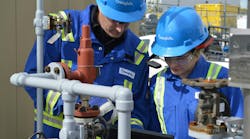(a.k.a. "The Pump Guy")
In an earlier article this year (“Energy Matters”, Flow Control, July 2012, pages 14–20), the Pump Guy posed some rhetorical questions regarding cavitation in pumps:
- Why is cavitation a misdiagnosed, mysterious, unknown phenomenon?
- Why isn’t cavitation eradicated like measles, polio, or dengue fever?
- Why can’t the reliability engineer resolve cavitation?
Cavitation exists because the deck of cards is stacked against the pump users in the municipal water plants, the chemical plants, and the oil refineries. That is a statement worthy of an explanation. So, let’s do it. I’ll start by defining the terms, “Cavitation,” “NPSHa” and “NPSHr.”
Cavitation is the formation and implosion of vapor bubbles inside a pump. The imploding vapor bubbles release violent energy and damage the pump internals. Cavitation occurs because of momentary inadequate energy. The most prominent type of cavitation — inadequate NPSHa cavitation (about 70 percent of all cavitation) — occurs due to inadequate suction energy available to the pump.
NPSHa is Net Positive Suction Head (energy) available to the pump. NPSHa is the energy in the liquid arriving into to the pump. The liquid and the pumping system determine this energy. Certain factors add or increase the available energy. Other factors subtract or decrease this energy. The addition and subtraction of these factors is the total energy, called NPSHa. The NPSHa must be greater than the NPSHr with an ill-defined safety margin.
NPSHr is Net Positive Suction Head (energy) required by the pump. It is the pump’s minimum energy requirement at the impeller’s eye. The NPSHr is charted at different flows on the pump’s performance curve.
The pump industry can make 70 percent of all cavitation go away if it would redefine NPSHr. Imagine resolving 70 percent of all mysterious pump failure, bearing failure, mechanical seal failure, and process pump downtime. Do I have your attention?
Defining NPSHr
What is wrong with the way NPSHr is currently defined? Let’s consider a human adult, and ask the question, “How much oxygen does a standard human need to function?”
Humans need air to live. Actually, we don’t need air; we need the oxygen in the air to live. Oxygen is about 19 percent of the gas we call air. We inhale oxygen and exhale carbon dioxide through our lungs. If we are deprived (starved) of oxygen, we will die. The degree of oxygen deprivation determines how soon before we die.
Let’s get 20 human adult test subjects. We put the human adults into a sealed chamber filled with atmospheric air.
Next, let’s slowly remove the oxygen from the air in our sealed chamber. We’ll take momentary samples of the air to record the oxygen content. We remove more and more oxygen from the sealed room until our test subjects are barely conscious with oxygen deprivation.
With our test subjects lying on the floor, teetering on the cusp between consciousness and “lala land” (fainted), we will record the oxygen content in the chamber with precise instrumentation. Then, we will remove another 3 percent of the oxygen from the air in the sealed chamber.
All test subjects faint from hypoxia after removing the additional 3 percent more oxygen from the chamber. Finally, we proclaim that this is the required oxygen that a standard adult human needs to function.
Does this seem natural? Does this seem logical? Believe it or not, this is the way NPSHr is defined in the United States.
The current NPSHr is a value representing a 3 percent loss in pump performance due to decreased suction energy. A new pump is mounted onto a test stand with instrumentation. The energy (head or pressure) is slowly removed from the suction side of the pump until the discharge output of the pump begins to suffer as noted by vibrations, amps, differential pressure, flow, and efficiency. Then, even more suction energy is removed and recorded until the pump’s discharge head is further reduced another 3 percent.
Let’s say the pump is designed to develop 100-feet of discharge head at best efficiency. The suction side of the pump is starved until the test pump can only develop 97 feet of discharge head. According to U.S. specifications, this value is considered the NPSHr of the pump at best efficiency. This is the value listed on the pump curve as the NPSHr.
Many pump users say, “This is crazy!” I agree. This is like the NHTSB (National Highway Traffic Safety Board) establishing the rule that the automobile bumper must withstand a 5 mph impact with no damage. Tremendous if you don’t drive more than 5 mph. When was the last time that you drove to work or the grocery store at 4 mph? How about a more realistic value?
Pump users demand NPSHr values reflecting ZERO loss of pump performance, and higher NPSHa safety margins. The pump manufacturers say that the new proposed values are prohibitive and impossible to meet.
Another Issue
Printed pump literature normally lists the NPSHr value at Best Efficiency. This is the value used by pump salesmen to sell a pump. This is the value touted in ads and promotional flyers. This is the value used to compare competing pumps for purchase.
However, Best Efficiency is practically never the actual duty point of a process pump. The operator normally has absolutely no idea where his pump is operating on its curve—because he doesn’t have, or doesn’t interpret, the instrumentation. So what happens?
As the pump migrates out to the right of the best efficiency point, the NPSHr rises exponentially, and the available energy (NPSHa) reduces. One of the elements of the NPSHa is the Hf (Friction Head), which robs (subtracts) energy from the liquid. So, more flow means more friction losses, which means less energy available to the pump.
Besides, most pump manufacturers insist on selling pumps without gauges, which is like selling new cars without a dash control panel. Imagine driving a car and not knowing the speed, the engine temperature or the level of fuel in the tank? This is how we operate pumps. It is also the reason most process plants are stuck on a 30-month MTBF plateau for rotating equipment.
Most instrumentation technicians are ready and waiting to install the adequate instrumentation on the equipment. But sadly, the process engineers and reliability engineers don’t even know what information they need to resolve problems in the pumps.
So we pretend that most pump failure is a surprise, unexpected, unanticipated event. We call the pumps “Bad Actors.” Who’s the real bad actor?
The Pump Guy favors realistic NPSHr values. The Pump Guy favors selling new pumps with gauges—that is, unless you like to continually rebuild and repair process pumps.
If you’re responsible for pump maintenance, keep this column or store this magazine where you can find it quickly. Tell the pump manufacturers what you need to do your job. See-ya on next year’s maintenance budget!!
Larry Bachus, founder of pump services firm Bachus Company Inc., is a regular contributor to Flow Control magazine. He is a pump consultant, lecturer, and inventor based in Nashville, Tenn. Mr. Bachus is a retired member of ASME and lectures in both English and Spanish. He can be reached at [email protected].



